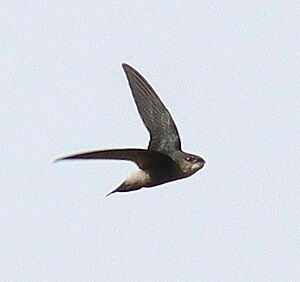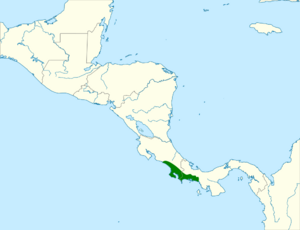Costa Rican swift facts for kids
The Costa Rican swift (Chaetura fumosa) is a small, fast-flying bird. It belongs to the swift family, known for their amazing flying skills. You can find this bird mainly in Costa Rica and Panama. Its scientific name is Chaetura fumosa.
Quick facts for kids Costa Rican swift |
|
|---|---|
 |
|
| Conservation status | |
| Scientific classification | |
| Genus: |
Chaetura
|
| Species: |
fumosa
|
 |
|
| Synonyms | |
|
Acanthylis spinicaudus fumosa |
|
Contents
About the Costa Rican Swift
For a long time, people thought the Costa Rican swift was just a type of band-rumped swift. But now, scientists agree it's its own unique species. It's the only bird of its kind (monotypic), meaning there are no different subspecies of it.
What Does It Look Like?
This swift is about 11 centimeters (4.3 inches) long. Both male and female swifts look the same. Their head is a dark, dusky color. Their upper body is mostly a sooty black, with a shiny blue tint. They have a pale grayish patch on their rump. Their throat and chest are also a light grayish color.
Where Does It Live?
The Costa Rican swift lives in southwestern Costa Rica. Its range extends east into western Panama, specifically in Chiriquí Province. Some bird experts also say it might be found in Colombia.
These birds live in many different places. You can find them over forests, open areas, pastures, and even farm fields. They usually live below 900 meters (about 2,950 feet) in elevation. However, in wetter areas, they can be found as high as 1,200 meters (about 3,900 feet).
How Does It Behave?
Staying in One Place
The Costa Rican swift is a resident bird. This means it stays in the same area all year long. It does not migrate to other places.
What Do They Eat?
Like all swifts, the Costa Rican swift eats insects while flying. They are called "aerial insectivores." They often hunt for food in groups. These groups can include other types of swifts and swallows. When they hunt only with other Costa Rican swifts, their groups can have up to 50 birds.
Scientists believe their diet is similar to the band-rumped swift. A study in Panama found that band-rumped swifts mostly eat flies (Diptera), bees and wasps (Hymenoptera), and beetles (Coleoptera).
Breeding Habits
Not much is known about how the Costa Rican swift breeds. Scientists have not yet described their nests or their eggs.
What Do They Sound Like?
The Costa Rican swift makes high-pitched calls. These can be single notes like "weet," "tsew," or "tsee." They often combine these with longer, chattering sounds. These longer calls might sound like "titititititititi" or "titititrrrr."
Is It Endangered?
The International Union for Conservation of Nature (IUCN) has looked at the Costa Rican swift. They have assessed it as a species of "Least Concern." This means it is not currently considered endangered.
Even though it lives in a somewhat small area, its population is healthy. There are an estimated 20,000 to 50,000 adult birds. This number is believed to be stable. No immediate threats to the species have been found. It is often the most common swift in its home range. It is very common in the lowlands of Costa Rica. It also lives in several protected areas.


